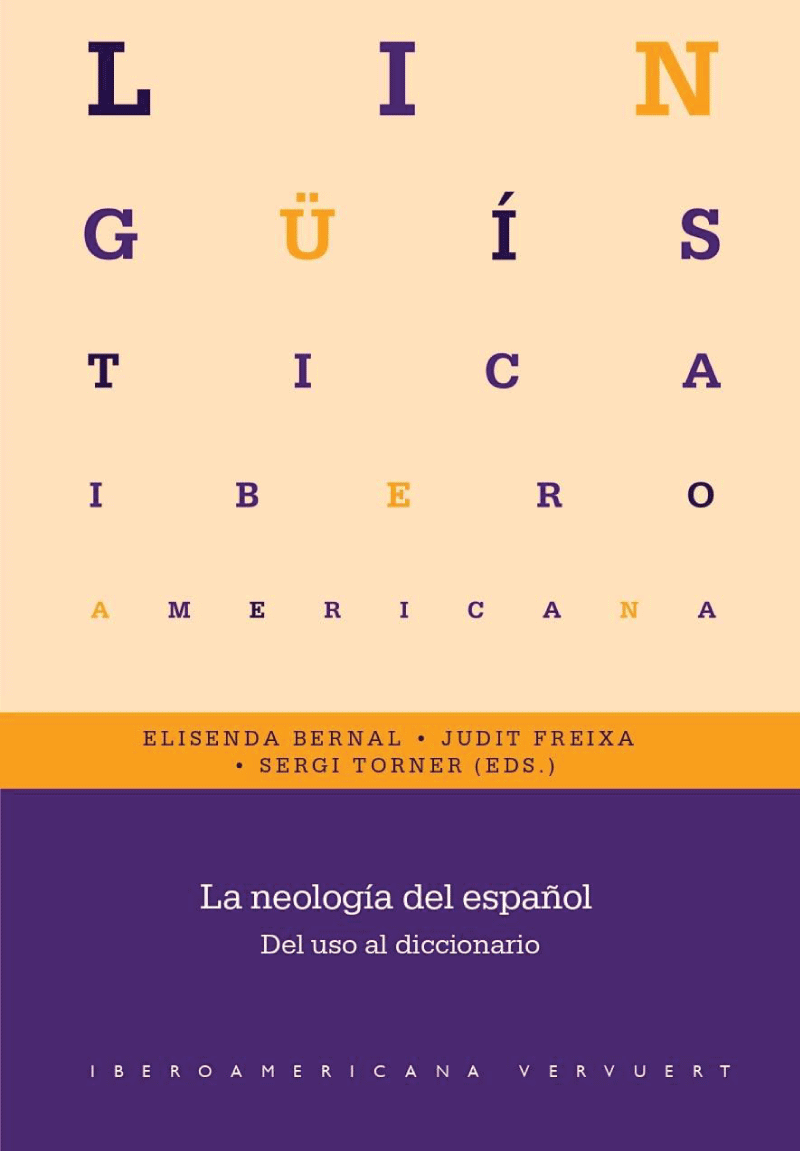
The Reference Book of the Neology of the Spanish Language
Educational Science Applied Sciences受け取った 13 May 2024 受け入れられた 25 Jun 2024 オンラインで公開された 26 Jun 2024
Focusing on Biology, Medicine and Engineering ISSN: 2995-8067 | Quick Google Scholar
Next Full Text
Theoretical Review on Microplastic Pollution: A Multifaceted Threat to Marine Ecosystems, Human Health, and Environment
Previous Full Text
The Impact of Teledentistry on Modern Dental Practice


受け取った 13 May 2024 受け入れられた 25 Jun 2024 オンラインで公開された 26 Jun 2024
This text presents a review of a fundamental book for the study of the neology of the Spanish language. This is a work published in 2022 to cover a space that had not been covered and that seeks to respond in a single work to the fundamental aspects according to its authors of the field of linguistics in charge of the creation of new terms and language evolution.
Elisenda Bernal, Judit Freixa & Sergi Torner (2022) La neología del español. Del uso al diccionario. Madrid: Iberoamericana-Vervuert. ISBN 978-8491922681
Within the current field of Applied Linguistics, Neology is an initially descriptive field that addresses the appearance of new words or lexical units [-] is a discipline in effervescence in the increasing global Spanish language []; in fact, since 1996 there has been the Observatori de neología (OBNEO) at the Pompeu Fabra University, in Barcelona, Spain. That is why this publication is an important event, as it aims to establish itself as a reference for the studies of neologisms in the Spanish language, the second language with the largest number of native speakers [] shared by twenty nations, essentially in America despite being originally from Europe and with a historical presence even in Asia and Africa.
Likewise, as an eyewitness, the writer has been able to see and study how within the Pan-Hispanic linguistic policy that presents Spanish as a language united in diversity and multiculturality of all those countries is shared, one of the main actions carried out consists of the School of Hispanic Lexicography since 2001 offering a Master’s degree to students from different Spanish-speaking countries to prepare specialists for the work of the normative corpus agreed upon by the Spanish language academies of countries where Spanish is the official language of the state [].
In such a scenario, the importance of a publication arising from the limited development of a specialized text has significant repercussions at times when Information and Communication Technology (ICT) modifies grammatical structures, but also the lexicon and the sociolinguistic repercussions, consequences or causes of the appearance of new voices, concepts, and realities defined with words [].
The book reviewed maintains the growing interest in this practical approach requires theoretical foundations to support the criteria that modulate the action of lexicographers and their decision to include, or not, new entries in dictionaries. In view of the fact after the second decade of the XXI century, no work could be introduced in a comprehensive manner providing the opportunity for researchers, teachers, students, and interested parties to have an updated vision, in the Introduction to this book the editors clarify the publication is proposed to fill this gap and be a monograph that offers an updated study of the issue on research in Spanish language Neology, both in its description and characterization as a linguistic object and in its relationship with lexicography and the establishment of criteria for the dictionaryization of forms and neological meanings.
“Neology of the Spanish language. From Use to Dictionary”, launched in the first quarter of 2022, is an excellent starting point for compiling seventeen interesting works grouped into three axes: “Fundamentals of Neology” (five texts), “The Neology of Dictionaries” (four texts) and “Neology in use” (eight texts). There are a total of 414 pages claiming to position themselves as the essential reference publication for those interested in these matters [].
The first part addresses practical and theoretical issues of the process that entails the appearance and use of a new expression, word, or lexical unit, and its stabilization until it is incorporated into the normative corpus. Certain aspects linked to lexical innovation and its cognitive and social processes in a global environment of linguistic change are also discussed. It offers a review of the research trends of the last decades, the poles of greatest influence in research in the Neology of the Spanish language that is, neologicity, glasodidactic aspects, available lexicon, applications for translation and psychosociolinguistic perspectives of the new voices. On the other hand, the five texts that make up the first axis also include issues associated with the creation and changes over time, the birth, establishment, and disappearance of the neologism, its characteristics, phases, and levels, and its cognitive-social, structural- morphological and institutional, without neglecting that these analyzes allow us to offer a pseudo-photography of the path taken by the lexicogenetic aspects of current peninsular Spanish. In this first part, it is notable that two of the three editors are authors of two of the five texts that make up this section, and all, without exception, have training and links to universities in Spain only.
In the second part, the link between neologism and dictionaries is developed to address the prescription criteria of dictionaries that intervene in whether or not to include a new lexical unit within the corpus, the impact and sanction of dictionaries, and linguistic loans to sustain that prescription and use, seeming to be sides of the same coin. Likewise, this second part includes work on the relevance of maintaining the general Neology and specialized Neology dichotomy, the dependence on English in the scientific field, and the importance of expanding linguistic policies toward these issues. This axis includes a work by the third editor of the book analyzing the complexity that exists when selecting the lemma of the dictionary, attitudes, and decisions of the lexicographers, and aspects of nomenclature modulating these processes related to the frequency of use, meanings, and, a little more light in an endless debate. As in the first part, all the authors of the second part have studied and are linked to Spanish Higher Education institutions.
In the third axis, of the eight texts that make up the longest part of the book, 25% are Hispanic American authors (from Argentina and Chile). The rest is essentially Catalan, since, as explained and justified, the reason is due to the “Neómetro” project of the Pompeu Fabra University, financed by the European Regional Development Fund (ERDF) and the State Research Agency (AEI) of Spain. However, this section presents descriptions of the main aspects associated with the use of neologisms, the discursive, the links neology-text type, neology-registration, geographical variation in neology, and neology-language contact.
This review is written considering the book “Neology of Spanish” is a success offering a first attempt to systematize the growing development of Neology studies of the Spanish language. It seems to be a work that demands more volumes in which case it would be advisable to open the local spectrum a little and transcend the Catalan, the Andalusian, the Galician, even the Canarian, or the Spanish. This has to be a staggered process, but if a new volume is produced it is necessary to include the contributions of specialists from Mexico, Colombia, Cuba, Venezuela, Peru, Costa Rica, Chile, etc., and reinforce and complement, the course, what has been done in Argentina with somewhat more Glottopolitical reading where ideology is critically addressed to overpass and move away from possible postcolonialist perceptions where specialists from countries with a majority of speakers of the Spanish language are underrepresented. From the first line of the book, there is an open sensitivity to the semantics and politics behind these pseudo-interventions or conceptions and attitudes about what is and is not, regarding the use of new nomenclatures, terminologies, or expressions. It should be noted this book does not fail to mention these issues, but the same publication cries out for Hispanic-American specialists to contribute to new volumes and provide a wider scope. Regarding Neology, it is convenient that criteria be aligned with a Pan-Hispanic disciplinary vision and focused on the dynamics of the lingua franca of the Pan-Hispanic civilization.
Nevertheless, this book is a fundamental publishing event and its impact is indisputable.
Guerrero-Ramos Gloria. "New orientations of terminology and neology in the field of lexical semantics. Magazine of Hispanic Philology. 2017; 33(3):1385-1415.
Rauhut, Marika. Neology and dictionary: regarding the registration of new lemmas in update 23.2. of the twenty-third edition of DEL. Master in Language and Literature (Theorical and Applied Linguistics). Spain: University Islas Baleares. 2019.
Kobchenko K, Kuzmenko K. Modern approaches to philological studies: collective monograph. Ukraine: Lviv-Toruń, Liga-Pres. 2020.
Guerrero-Ramos Gloria. Terminology, neology and translation. Spain: Comares Editorial. 2021.
Cervantes Institute. Spanish Report Living Language. Spain. 2023.
Real Academia Española (RAE). May, 2024. https://www.rae.es/la-institucion/escuela-de-lexicografia-hispanica/la-elh
Maxbuba Z. “Pedagogical neology: A comprehensive review and implications for education”. International Journal of Pedagogics. 2023;3(5):161-168.
Bernal E, Freixa J, Torner S. The neology of Spanish. From use to dictionary. Madrid: Iberoamericana-Vervuert. 2022. ISBN 978-8491922681
Meza-Morales JA. The Reference Book of the Neology of the Spanish Language. IgMin Res. Jun 26, 2024; 2(6): 473-475. IgMin ID: igmin205; DOI:10.61927/igmin205; Available at: igmin.link/p205
次のリンクを共有した人は、このコンテンツを読むことができます:
Address Correspondence:
Jesús A Meza-Morales, University of The Bahamas, Bahamas, Email: [email protected]
How to cite this article:
Meza-Morales JA. The Reference Book of the Neology of the Spanish Language. IgMin Res. Jun 26, 2024; 2(6): 473-475. IgMin ID: igmin205; DOI:10.61927/igmin205; Available at: igmin.link/p205
Copyright: © 2024 Meza-Morales JA This is an open access article distributed under the Creative Commons Attribution License, which permits unrestricted use, distribution, and reproduction in any medium, provided the original work is properly cited.
 Figure 1: ...
Figure 1: ...
 Figure 1: ...
Figure 1: ...
 Figure 1: ...
Figure 1: ...
 Figure 1: ...
Figure 1: ...
 Figure 1: ...
Figure 1: ...
Guerrero-Ramos Gloria. "New orientations of terminology and neology in the field of lexical semantics. Magazine of Hispanic Philology. 2017; 33(3):1385-1415.
Rauhut, Marika. Neology and dictionary: regarding the registration of new lemmas in update 23.2. of the twenty-third edition of DEL. Master in Language and Literature (Theorical and Applied Linguistics). Spain: University Islas Baleares. 2019.
Kobchenko K, Kuzmenko K. Modern approaches to philological studies: collective monograph. Ukraine: Lviv-Toruń, Liga-Pres. 2020.
Guerrero-Ramos Gloria. Terminology, neology and translation. Spain: Comares Editorial. 2021.
Cervantes Institute. Spanish Report Living Language. Spain. 2023.
Real Academia Española (RAE). May, 2024. https://www.rae.es/la-institucion/escuela-de-lexicografia-hispanica/la-elh
Maxbuba Z. “Pedagogical neology: A comprehensive review and implications for education”. International Journal of Pedagogics. 2023;3(5):161-168.
Bernal E, Freixa J, Torner S. The neology of Spanish. From use to dictionary. Madrid: Iberoamericana-Vervuert. 2022. ISBN 978-8491922681